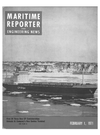
Page 4: of Maritime Reporter Magazine (February 1971)
Read this page in Pdf, Flash or Html5 edition of February 1971 Maritime Reporter Magazine
The first of CP Ships' new 700-contoiner vessels, the CP Voyageur, arrived at Quebec City on Dec. 20 loaded with containers from London and Rotterdam. The 16,000-dwt vessel and its two sister ships now under construction at Birkenhead, England, cost a total of $20,- 000,000 and are designed to permit eventual stretching to 1,000 container capacity. The three vessels will operate a weekly service between London, Rotterdam end Quebec. Equip- ment at the container terminal at Wolfe's Cove completely reloaded the ship in two days.
CP Ships' vessel Beavercak was stretched to increase its capacity to 322 containers and renamed the CP Ambasscdor. The $900,000 PACECO-Vickers Portainer Crane at CP Ships' new highly mechanized container terminal unloads the CP Ambassador at a rate of almost 40 containers per hour. The new facilities permit this vessel to completely unload and re- load in 30 hours. The terminal, which has a weekly throughput of 1,600 containers each way, is the key to CP Ships' successful North Atlantic container services.
CP Container Port Designed For Fast Throughput
The official opening of CP Ships' fully- integrated container terminal at Wolfe's Cove, a little upstream from Quebec City, Canada, by Premier Robert Bourassa on December 5, marks the completion of the most important step in a $30-million containerization program announced in October 1968.
Announcing the choice of Quebec City in 1968, CP Ships chairman W.J. Stenason said: "This port best suits the economic and com- petitive factors of our particular trade chan- nels. Quebec City is also best suited to the integrated ocean, rail and road system which
Canadian Pacific can muster to move con- tainers."
The fully-equipped double berth terminal will serve as the land-ocean link for CP Ships' rapidly expanding North Atlantic container operations. These services link all parts of
Canada and the U.S. midwest with Western
Europe through four United Kingdom and
Continental ports.
The new facilities at Wolfe's Cove are de- signed to optimize the efficiency of ship load- ing and unloading as well as rail and truck terminal operations. Coordination of Portain- er and Transtainer crane activities by use of the versatile straddle carriers ensures a weekly throughput capacity of 1,600 containers each way.
Transformation of the Wolfe's Cove area from a temporary facility to a modern highly mechanized terminal began last April. Ex- isting rail trackage at the site had to be com- pletely removed to clear the area for the container park and the four-track loading and marshaling railhead at the rear of the site.
This task, which cost CP Rail $500,000, also included further reorganization of the other tracks in the vicinity to create the necessary back-up tracks for making up full trains.
Key to the rapid loading and unloading of trucks and trains is the 74-foot-wide, 35-ton- capacity Transtainer crane which straddles the four-track railhead and a 16-foot-wide truck and straddle carrier lane, on two 1,600-foot- long concrete runways. Containers deposited by the straddle carriers are loaded onto flatcars on any of the four tracks by the 50-foot-high
Transtainer. Trains marshaled for different destinations can thus be made up simulta- neously, as a ship is unloaded. Containers moving out by truck can be loaded directly from the ship.
A separate company, Transport Terminals
Ltd., has been formed by CP Ships to operate and maintain the terminal facilities. The com- pany is building a garage and other mainte- nance facilities for its moveable equipment.
The most important and complex piece of equipment on the site is the giant 35-ton-ca- pacity PACECO-Vickers Portainer crane. The electrically operated Portainer moves along the edge of the terminal's two ship berths on a 1,200-foot-long, 50-foot gage track. The
A six-wheel, triple stacking straddle carrier unloads a 20- foot container from a CP Express trailer truck at CP Ships' new container terminal at Quebec City. In the background is the terminal's $900,000 Portainer crane. boom of the $900,000 machine has a 110-foot outreach from the edge of the dock over arriv- ing ships, at a height of 65 feet above the dock. Effective backreach of the crane is 30 feet beyond its rear legs which are 55 feet from the dock edge. When not in use, or when a ship is docking, the Portainer outreach boom is raised to a vertical position, giving the crane an overall height of 208 feet. For optimum visual control, the operator's cab is attached directly to the lifting apparatus and moves along the boom with the container load from ship's hold to dock area.
The crane has elaborate safety measures and back-up systems in case of mechanical or electrical failures, while the operator's con- trols permit only certain specified activities to occur simultaneously. The Portainer nor- mally averages about 40 container movements per hour. "The challenge of operating a container ter- minal is to achieve rapid ship turn-arounds," said Bernard Genest, president of Transport
Terminals. "The effectiveness of any trans- portation system involving different modes of transport is largely limited by the efficiency of the interface movements between the dif- ferent modes. For containerization, where each mode completes its portion of the total movement as rapidly as possible, throughput movements become even more crucial. "When ships are involved, this throughput must be achieved in both directions at once.
That is why all aspects of our terminal opera- tion are carefully planned to complement each other," stated Mr. Genest.
As containers arrive for a specific ship, they are laid out in the 2,400-container-capacity paved park area in a specific loading pattern, according to destination and the space charac- teristics of the vessel in which they will be (Continued on page 8) 6 Maritime Reporter/Engineering News

 3
3

 5
5
